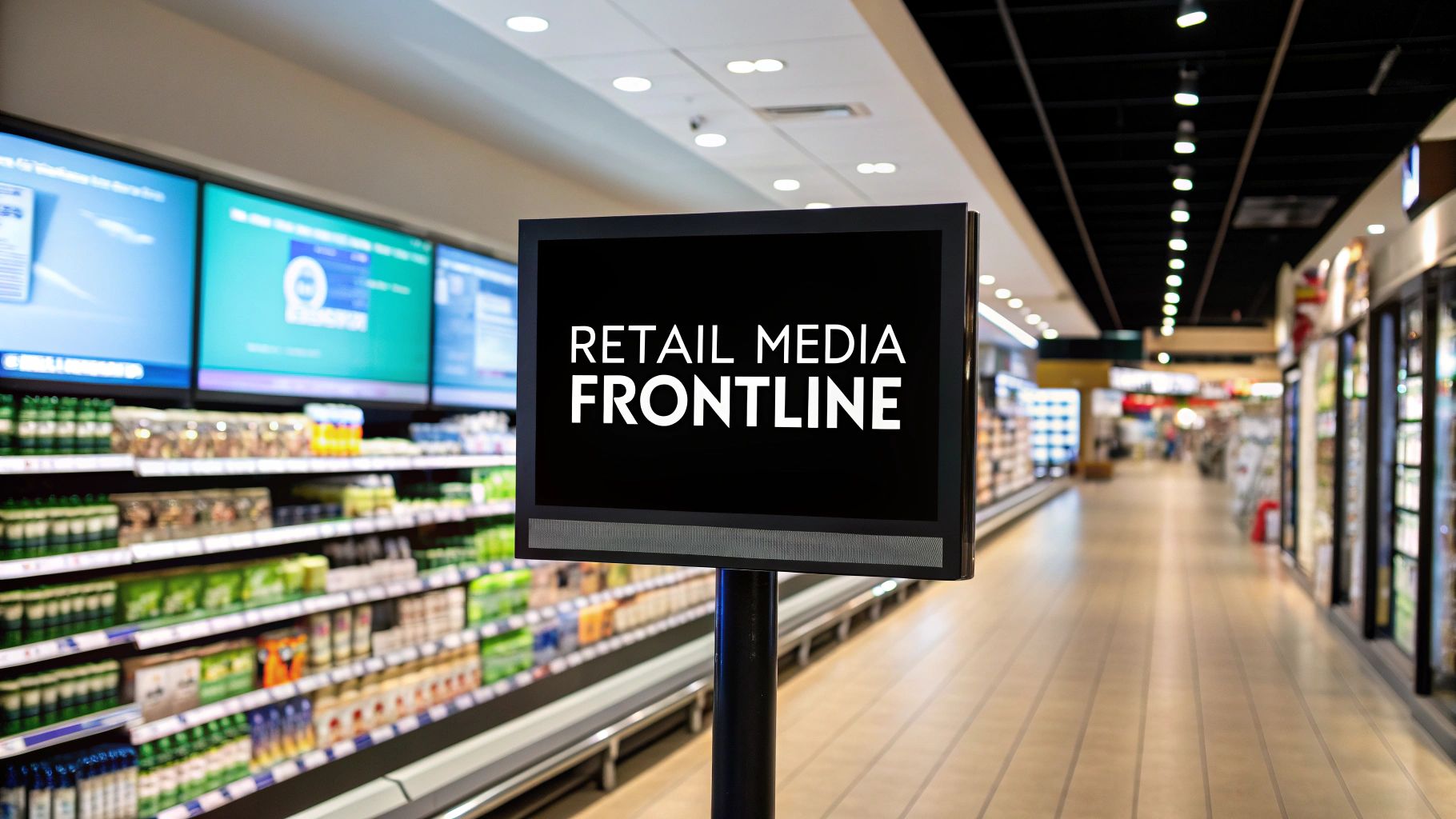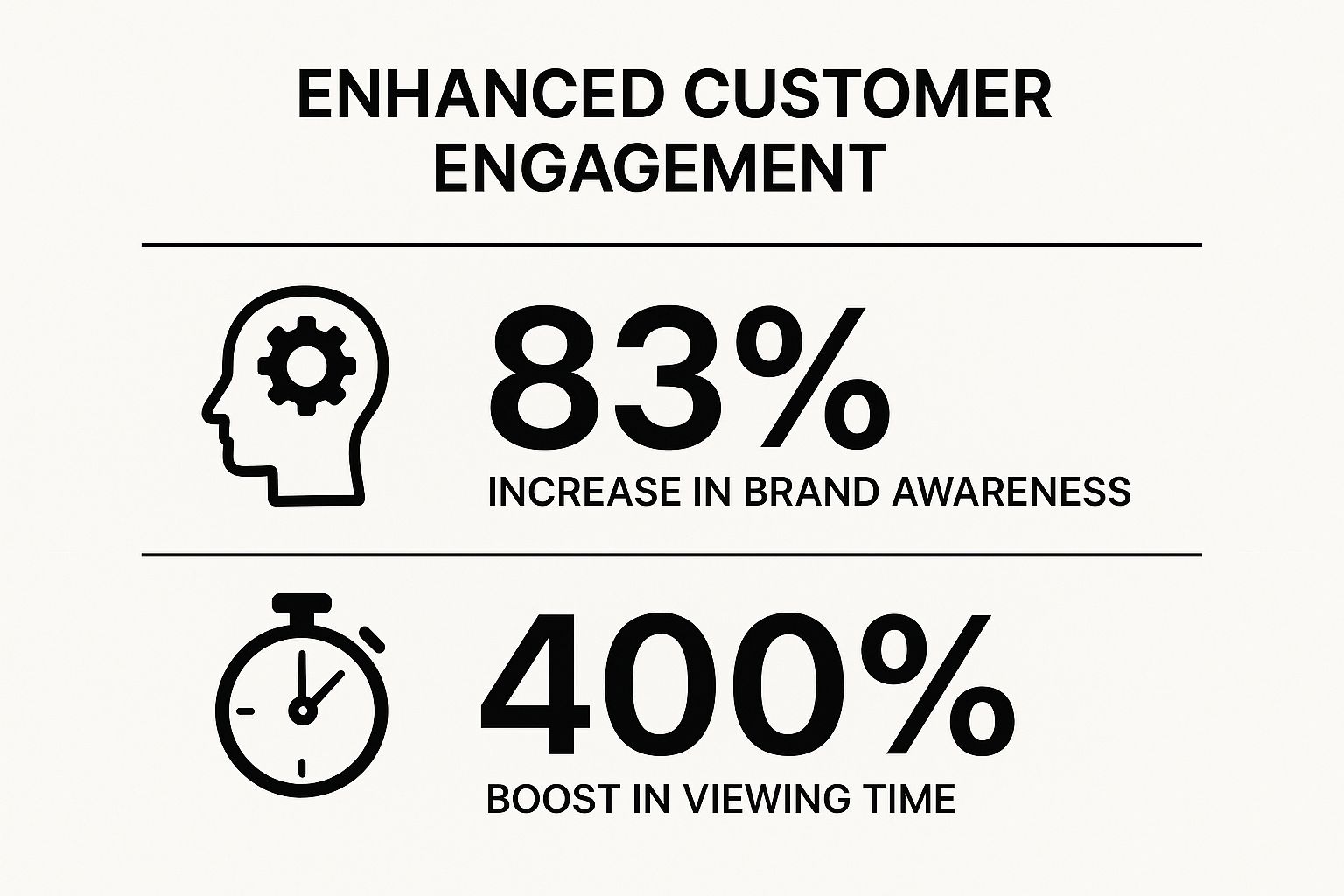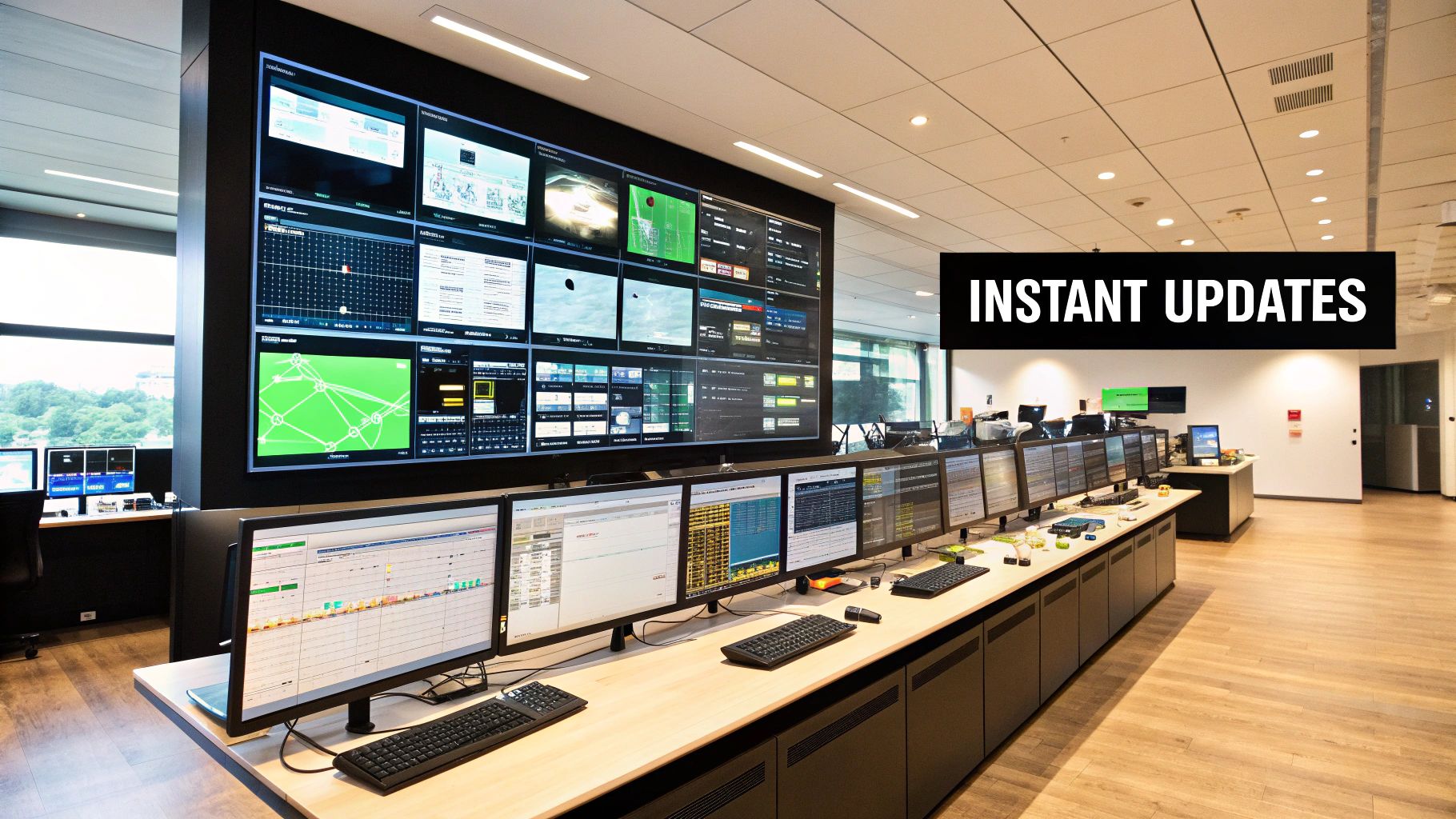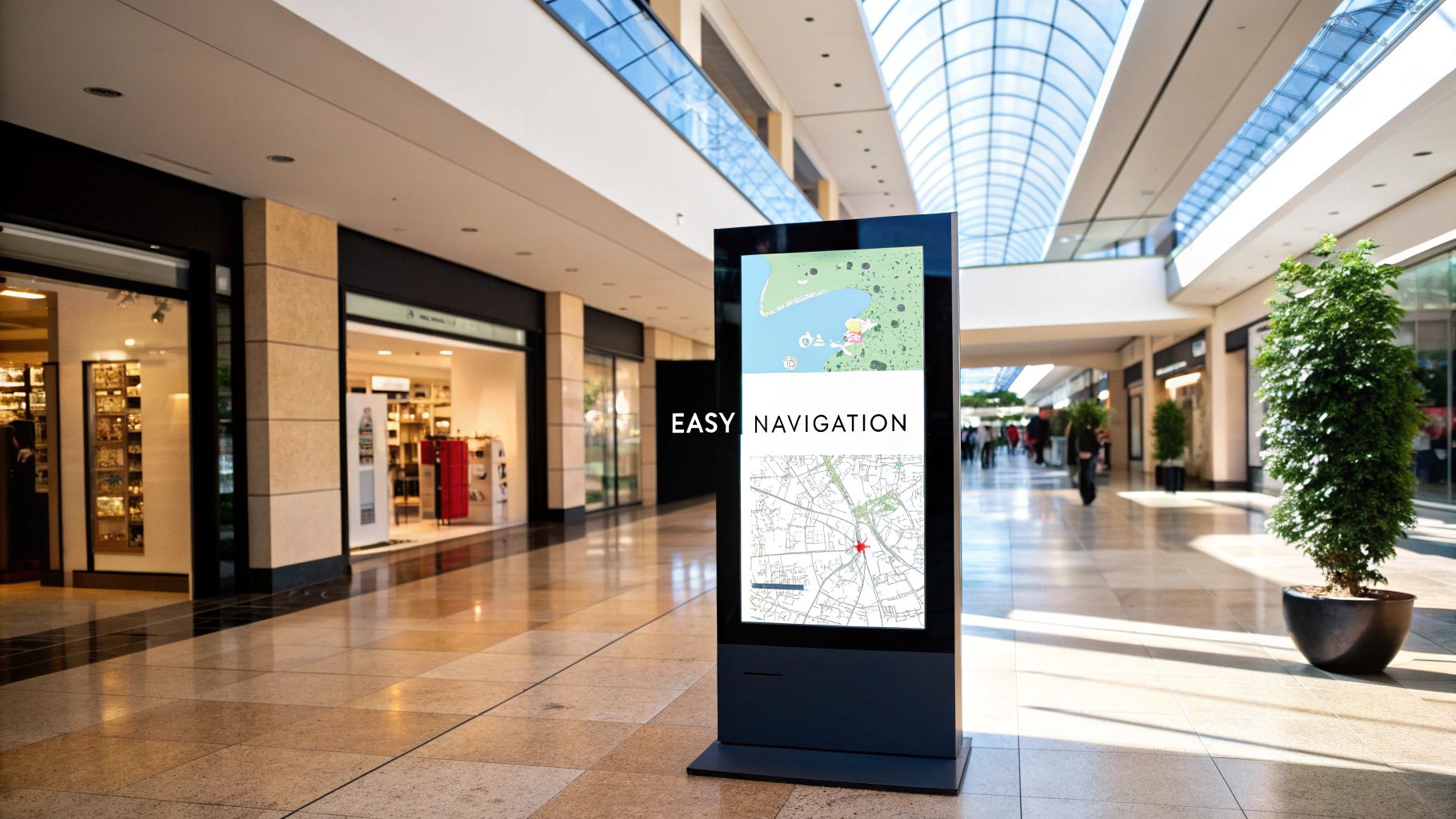

As digital privacy regulations dismantle third-party cookies, the battle for consumer attention is shifting from online browsers to physical aisles. For brick-and-mortar retailers and CPG brands, this is not a crisis but a monumental opportunity. The challenge is no longer just about reaching consumers online; it's about connecting with them meaningfully in the final moments before purchase—a critical touchpoint where decisions are made. This shift requires a strategic pivot, and in-store media is the new frontline.
This article moves beyond abstract concepts to provide a data-backed breakdown of this new reality. We will explore the tangible benefits of digital signage, not as a simple hardware upgrade, but as the core of a sophisticated, AI-driven retail media network. Here’s what most retailers miss: by using insights from platforms like Intouch.com, which serves millions of personalized ads daily in stores like Circle K, you can dissect how this technology addresses the attribution gap left by online advertising. For those looking to capitalize on this shift, understanding advanced in-store tactics is crucial; diving into powerful grocery store marketing strategies can provide a solid foundation.
Let's break down what this really means for brands and retailers aiming to boost engagement, unlock new revenue, and win at the point of sale. You will learn how to transform static screens into dynamic, data-driven assets that drive measurable results.
In an era of divided attention, one of the most significant benefits of digital signage is its proven ability to cut through the noise. Unlike static posters that quickly blend into the background, digital displays leverage dynamic motion, vibrant colors, and rich multimedia to capture and hold customer focus, creating a more memorable brand interaction.
Static signs are passive; digital signage is an active participant in the customer journey. By presenting engaging content like high-definition video, animations, and real-time information, businesses can transform a simple point-of-sale into an immersive experience. This active engagement keeps customers in-store longer, guides their purchasing decisions, and strengthens brand recall long after they leave. The goal is to move beyond simply displaying information and start creating a dialogue with your audience.
Dynamic content is the engine of engagement. Consider these real-world examples:
Retail: A Nike store uses interactive touchscreens allowing shoppers to customize sneaker designs in real-time, turning a passive browsing experience into an active, creative one.
QSR: McDonald's digital menu boards feature appetizing video loops of sizzling burgers and fresh salads, influencing ordering decisions through sensory appeal.
Public Spaces: The iconic billboards of Times Square create immersive brand narratives that captivate millions of passersby daily.
The data below visualizes two critical metrics that highlight how digital displays outperform their static counterparts in capturing audience attention.

These statistics reveal a profound shift in consumer attention, showing that dynamic displays not only attract more eyes but also hold them significantly longer, increasing the opportunity for message absorption. For brands and retailers, this translates directly into stronger brand recognition and influence at the critical point of purchase. To see how these principles can be applied to your strategy, learn more about how to increase shopper retention with engaging in-store media.
While the initial investment for digital signage is higher than for traditional signs, one of its most compelling long-term benefits is its significant cost-effectiveness. Static signage incurs recurring expenses for printing, distribution, installation, and disposal. Digital signage eliminates these ongoing costs, allowing businesses to reallocate budgets toward strategy and content creation rather than materials.
The traditional model of print-and-replace is not only expensive but also slow and inefficient. With a digital signage network, content updates are instantaneous and can be deployed across hundreds of locations from a single dashboard at no additional material cost. This operational agility means promotional campaigns can be launched, modified, or ended in real-time, reducing waste and maximizing return on investment. The focus shifts from managing physical assets to optimizing dynamic content, creating a far more sustainable financial model.
Viewing digital signage as a capital expenditure rather than a recurring operational cost reveals its true value. Consider these real-world scenarios:
Quick Service Restaurants: A QSR chain like Starbucks or McDonald's saves tens of thousands of dollars annually by eliminating the need to print and ship new menu boards for price changes, new items, or limited-time offers.
Retail Chains: A large retailer like Walmart avoids massive printing bills for weekly promotions and seasonal campaigns, instead pushing updates to thousands of screens instantly.
Corporate Offices: Companies can reduce internal communication printing costs by over 80%, using digital screens in common areas to share updates, dashboards, and company news.
The financial advantage becomes clear when comparing the total cost of ownership (TCO) over a five-year period. While the upfront cost for digital is higher, the cumulative savings from eliminating print-related expenses quickly lead to a crossover point where digital becomes the more economical choice.
These figures demonstrate that the initial hardware and software investment is quickly offset by the elimination of recurring material and labor costs. For organizations planning for sustainable growth, this makes digital signage a fiscally responsible decision. By investing in quality, energy-efficient hardware and a robust content management system, businesses can secure a lower TCO and a higher ROI. To explore ROI-focused solutions for your business, learn more about how to monetize your in-store traffic with AI-driven media.
In a fast-paced market where adaptability is paramount, one of the key benefits of digital signage is its unparalleled flexibility. Unlike static print media, which requires manual replacement and involves significant lead times, digital displays can be updated instantly across an entire network of screens from a single, centralized platform. This agility empowers businesses to respond to market shifts, emergencies, or time-sensitive opportunities with immediate effect.

The ability to deploy real-time content transforms operational efficiency and marketing responsiveness. This system allows for precise control, ensuring that promotions, pricing, and critical communications are always accurate and relevant. For retailers and brands, this means eliminating the waste associated with outdated print materials and capitalizing on micro-moments, like a sudden change in weather or a competitor's stock outage, to drive immediate sales.
The capacity for instant updates is crucial for maintaining relevance and operational control. Consider these practical applications:
Restaurants: A quick-service restaurant can update its digital menu to mark an item as "sold out" or feature a daily special, preventing customer disappointment and managing inventory effectively.
Transportation: Airports like those managed by Delta Airlines use digital displays to provide real-time flight information, gate changes, and delay notifications, improving passenger flow and reducing stress.
Corporate: A company can broadcast urgent company-wide announcements, safety alerts, or welcome messages to all office locations simultaneously, ensuring consistent and timely communication.
The ability to make instant, network-wide changes offers a distinct competitive advantage. The data below highlights the operational speed and reach of digital signage compared to the logistical challenges of traditional static media. This agility is a core reason why forward-thinking retailers like Target have embraced digital systems for their promotional campaigns.
To harness this power, businesses must establish clear content workflows and train staff on the content management system. Building a library of pre-approved templates allows for rapid deployment of common updates, such as flash sales or emergency notices. By preparing for various scenarios, organizations can maximize the responsiveness that makes digital signage such a powerful tool. Learn more about how to build a successful digital signage content strategy that leverages real-time capabilities.
One of the most practical benefits of digital signage is its ability to transform a potentially confusing physical space into a navigable and welcoming environment. By providing clear, on-demand directional assistance and relevant information, digital displays significantly reduce customer frustration, streamline traffic flow, and create a more positive overall brand perception.

Unlike static maps that can be outdated or difficult to interpret, interactive digital wayfinding offers a dynamic, user-centric solution. It empowers customers to find what they need quickly, whether it's a specific department in a large hospital or a store in a sprawling mall. This proactive assistance not only improves satisfaction but also frees up staff from repeatedly answering directional questions, allowing them to focus on higher-value service interactions.
Effective wayfinding is about more than just maps; it's about delivering the right information at the right time. Consider these real-world examples:
Hospitals: The Mayo Clinic uses interactive kiosks to provide patients with step-by-step directions to appointments, reducing stress and late arrivals.
Shopping Malls: Westfield shopping centers deploy sleek digital directories that not only show store locations but also highlight current sales and promotions, guiding foot traffic and influencing purchase decisions.
Transportation Hubs: Airports use digital signage to display real-time flight information, gate changes, and security wait times, helping travelers navigate complex terminals with confidence.
Efficient wayfinding enhances customer journeys and boosts operational efficiency by simplifying navigation. Clear paths lead to happier customers and improve satisfaction scores while reducing the need for staff assistance. Investing in digital wayfinding benefits both customer experiences and operational performance. Learn more about seamless customer journeys with interactive digital solutions.
One of the most transformative benefits of digital signage is its ability to move beyond passive broadcasting into the realm of data-driven intelligence. Unlike traditional media, which offers little to no feedback, modern digital displays act as powerful sensors, gathering actionable data on audience behavior, content performance, and campaign effectiveness. This closes the feedback loop, allowing businesses to measure, refine, and prove their ROI with precision.
Static advertising relies on assumptions; digital signage delivers certainty. Based on data from thousands of stores, we see that by leveraging integrated analytics technologies, you can stop guessing and start knowing what resonates with your audience. This data-driven approach allows for strategic optimization, ensuring that every message is fine-tuned to deliver maximum impact. The ability to measure engagement in real time means campaigns can be adjusted on the fly, transforming marketing from a fixed expense into a dynamic, performance-driven investment.
Actionable analytics turn displays into strategic business tools. Consider these real-world examples:
Retail: A store can analyze foot traffic and dwell times in front of a specific product display to measure engagement, A/B testing promotional videos to see which one drives more sales.
QSR: A fast-food chain optimizes its digital menu board layout by analyzing which items customers look at the longest, strategically placing high-margin products in prime viewing spots.
Trade Shows: An exhibitor uses viewer analytics at their booth to track how many people engaged with their presentation and for how long, helping to qualify leads and measure event success.
The data below illustrates the direct correlation between leveraging analytics and improving campaign outcomes. It highlights how a data-informed strategy significantly outperforms a static, non-optimized approach.
These statistics demonstrate that a data-driven content strategy is not just marginally better; it is exponentially more effective. When businesses use analytics to refine their messaging, they can see up to a 400% uplift in campaign performance. This shift from passive advertising to active, intelligent communication is a core advantage that defines modern digital signage. To explore how analytics can power your in-store media, learn more about Intouch.com's AI-driven solutions.
Beyond capturing attention, one of the most compelling benefits of digital signage is its direct and measurable impact on the bottom line. Digital displays are powerful sales tools, strategically influencing purchasing decisions at the most critical moment: the point of sale. By showcasing promotions, upselling opportunities, and highlighting high-margin products with compelling visuals, businesses can transform passive browsing into active buying, leading to significant revenue growth.
Static promotions are easily overlooked, but dynamic, data-driven advertising actively guides consumer behavior. Research confirms this impact, with studies showing digital displays can increase overall sales by an average of 31.8%. Digital signage is a cornerstone of modern retail, contributing significantly to sales when combined with other top in-store marketing tactics. The goal is to move from simply listing prices to creating irresistible offers that drive immediate action and boost basket size.

Strategic content is the key to converting views into sales. Consider these real-world examples:
QSR: A fast-food chain like Subway uses digital menu boards to display enticing visuals of combo meals, effectively upselling customers from a single sandwich to a higher-value meal.
Retail: A Sephora store uses screens to demonstrate a new beauty product, showing its application and results, which can boost sales of that specific item by over 40%.
Convenience: Gas stations place digital screens at the pump to promote in-store deals on snacks and drinks, driving foot traffic and encouraging impulse buys.
The data below illustrates how strategically placed digital signage directly influences consumer spending habits and boosts sales for promoted items.
These figures demonstrate a clear correlation between dynamic digital promotions and consumer purchasing behavior. By presenting the right offer to the right customer at the right time, businesses can effectively steer decisions and maximize revenue from existing foot traffic. For brands looking to leverage this potential, it is crucial to implement a strategy that aligns content with sales objectives. To explore how AI-driven platforms can optimize your promotional strategy, learn more about how to increase your in-store sales.
While often viewed as a customer-facing tool, one of the most transformative benefits of digital signage is its impact on internal company culture. In today's hybrid work environment, digital displays provide a centralized, dynamic channel to unite employees, whether they are on the manufacturing floor, at corporate headquarters, or in a retail backroom. This creates a cohesive and informed workforce.
Static notice boards and easily-ignored emails are relics of a past era. Digital signage actively captures employee attention with vibrant, real-time updates. By broadcasting company news, celebrating team wins, and reinforcing safety protocols with engaging visuals, organizations can significantly boost information retention and employee engagement. The goal is to create a living, breathing communication hub that makes every team member feel connected to the company's mission.
Dynamic content is the key to transforming the workplace into an engaged community. Consider these real-world examples:
Manufacturing: A General Electric facility displays live production metrics, safety reminders, and highlights team achievements, fostering a culture of safety and performance.
Corporate: Microsoft uses digital screens in its offices to share company-wide announcements, stream town hall meetings, and showcase innovative projects, keeping its global workforce aligned.
Retail: A flagship store updates its back-of-house screens with hourly sales targets, top-performing employees, and new product information, motivating staff and driving results.
Data from various studies confirms the profound impact of digital screens on internal communications. The statistics below highlight how digital displays significantly outperform traditional methods in engaging employees and ensuring critical information is seen and retained.
These figures demonstrate that dynamic displays are not just a modern convenience; they are a strategic tool for building a more connected and productive workforce. For businesses looking to improve morale, streamline operations, and reinforce their core values, investing in internal digital communication provides a clear and measurable return. To explore how to integrate these solutions, discover more about building a connected workplace with smart communication tools.
Maintaining a cohesive brand identity across multiple locations is a significant challenge, but it's one of the key benefits of digital signage. Centralized control over a network of screens ensures every message, from promotions to brand stories, is presented uniformly. This consistency reinforces brand recall and trust, projecting a modern, technologically sophisticated image that resonates with today’s consumers.
Unlike static signage, which can suffer from printing inconsistencies, shipping delays, and off-brand local execution, digital displays guarantee that the correct, approved content is live everywhere at once. This ability to instantly deploy brand-aligned messaging across an entire network elevates the customer perception of your business, transforming it from a simple store into a professional, cohesive brand experience. This consistency is critical for building a strong, recognizable brand identity.
A unified brand presentation builds customer confidence and enhances perceived value. Consider these real-world examples:
Luxury Retail: A brand like Apple uses identical, sleek digital displays in every store worldwide to reinforce its premium, minimalist aesthetic and innovative identity.
Fast-Casual Restaurants: Starbucks implements globally standardized digital menu boards and promotional screens to ensure customers receive the same familiar, high-quality brand experience, whether in Seattle or Singapore.
Corporate Offices: Major corporations use digital signage in their lobbies to project an innovative company culture, welcoming visitors with dynamic content about company achievements, values, and news.
Data shows that a consistent and professional brand presentation directly impacts how customers perceive and trust a business. To truly leverage digital signage for brand consistency, it's crucial to have a strong foundation in understanding the core principles of visual branding.
The statistics below highlight how a technology-forward approach with digital signage enhances brand perception, leading to greater recognition and trust.
These metrics underscore a vital point: a modern, consistent visual identity is not just about aesthetics; it directly influences customer loyalty and perceived credibility. By investing in a unified digital signage strategy, businesses can control their narrative and ensure their brand is perceived exactly as intended. Learn more about how to build a powerful and consistent brand identity with the right digital tools.
The evidence is clear: the benefits of digital signage are no longer a futuristic concept but a present-day reality for savvy retailers and CPG brands. We have moved beyond simply displaying bright, static advertisements. Today’s in-store media represents a fundamental pivot in retail strategy, transforming physical spaces into dynamic, data-rich environments where customer engagement, real-time analytics, and revenue generation converge. From enhancing the customer journey with interactive wayfinding to driving impulse purchases at the point of decision, digital screens have become the new frontline in a post-cookie world.
The industry's most prominent players, from Walmart Connect to Kroger Precision Marketing, are already capitalizing on this shift. They understand that as third-party data becomes less reliable, the rich, first-party behavioral data captured in-store is invaluable. This creates an unparalleled opportunity for retailers to build powerful, high-margin retail media networks and for brands like Unilever or Heineken to reach engaged shoppers with unparalleled precision. The question is no longer if in-store digital media is a viable strategy, but how you will implement it to claim your share of this growing market.
Here’s what most retailers and brands miss: the key is to start with a focused, data-first approach rather than attempting a massive, high-cost overhaul. An incremental, proof-of-concept strategy de-risks the investment and builds momentum.
Step 1: Identify High-Value Zones. Begin by analyzing your store traffic patterns. Pinpoint two or three high-traffic, long-dwell-time locations, such as endcaps in the beverage aisle, the checkout queue, or the deli counter. These are your pilot zones.
Step 2: Establish a Baseline. Before deploying new content, use an analytics platform to measure baseline performance. Understand current sales volume for specific products in these zones to create a benchmark for success.
Step 3: Launch a Targeted Pilot Campaign. Partner with a CPG brand to run a hyper-targeted campaign on screens in your pilot zones. Using an AI-driven platform allows you to schedule content based on time of day, shopper demographics, and even inventory levels.
Step 4: Measure, Iterate, and Prove. The most critical step is to connect the campaign to tangible results. By leveraging POS data integration, you can directly attribute sales lift to your digital signage efforts. A 15% increase in sales for a featured product becomes a powerful case study, proving the ROI needed to justify scaling the initiative across your entire network.
By following this strategic roadmap, you transform the conversation from an expensive capital expenditure into a self-funding, high-growth revenue engine. You are not just buying screens; you are building an intelligent, monetizable media channel that turns store aisles into powerful and profitable revenue streams.
Ready to transform your physical retail space into a high-performance media network? Discover how the AI-driven platform from Intouch.com provides the real-time analytics and campaign management tools needed to unlock the full potential of your in-store traffic. Visit Intouch.com to see how you can start measuring and monetizing the benefits of digital signage today.